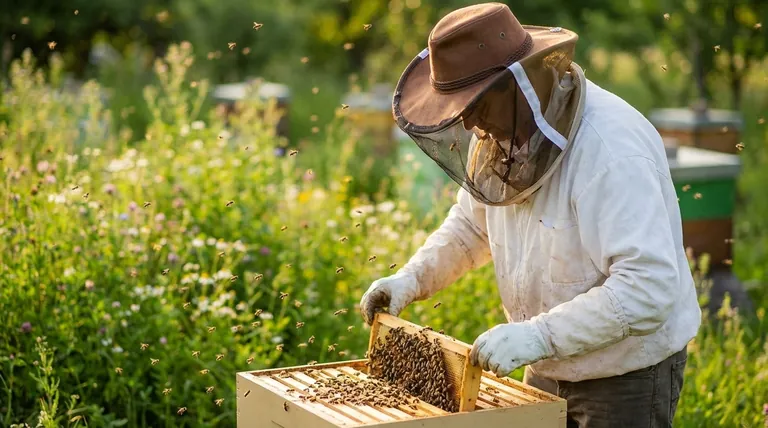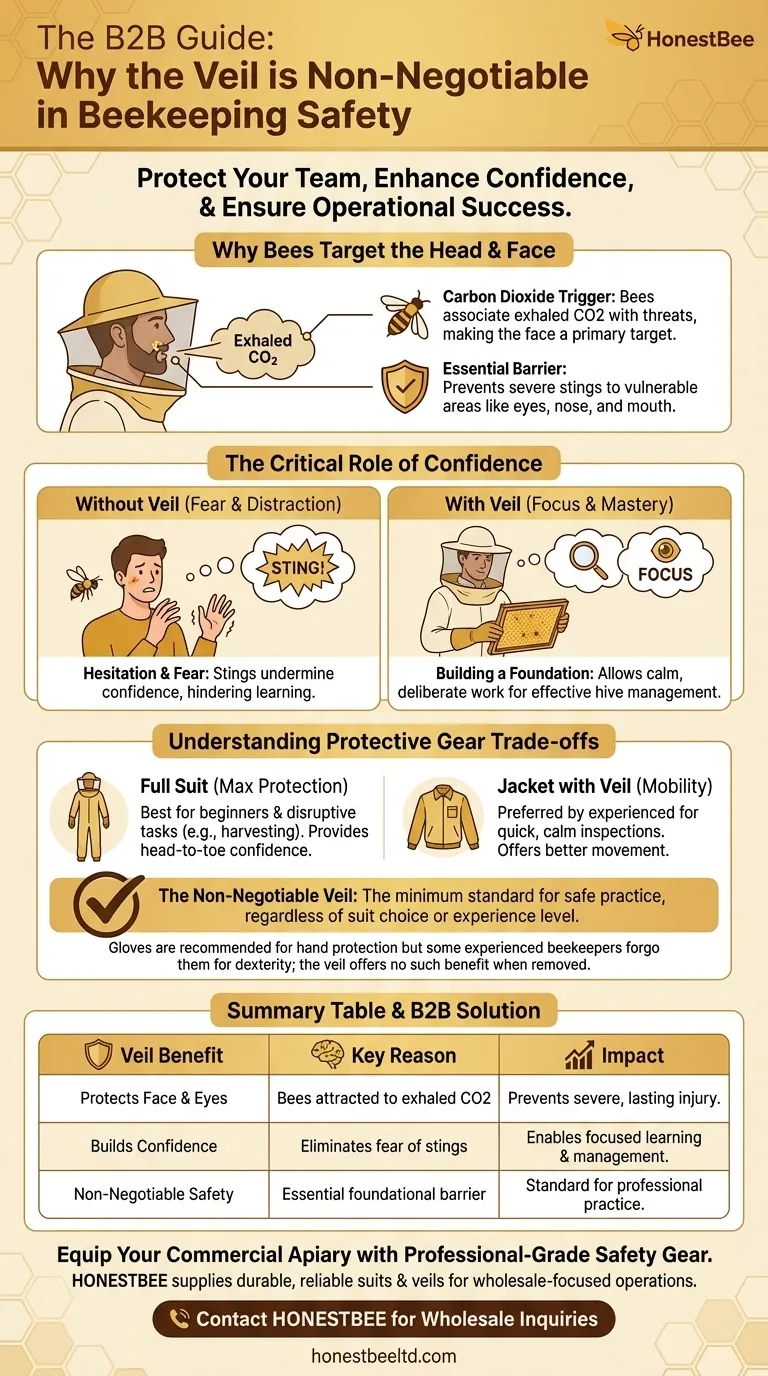The single most important reason to always wear a veil when working with bees is to protect your face and eyes from stings. Bees are naturally drawn to the carbon dioxide you exhale, making your head a primary target for defensive behavior. While a sting anywhere is unpleasant, a sting to the face—and especially the eyes—can be uniquely dangerous.
The veil is not just about avoiding pain; it's a non-negotiable safety measure. It protects your most vulnerable areas from a bee's natural defensive instincts, allowing you to work with the focus and confidence required for successful beekeeping.

Why Bees Target the Head and Face
The recommendation to wear a veil is rooted in a fundamental understanding of honey bee behavior. Their defensive actions are not random; they are often directed at specific perceived threats.
The Carbon Dioxide Trigger
Bees have evolved to associate the carbon dioxide exhaled by large mammals with a potential threat to their hive. When you lean over a hive, you are breathing directly into their space. This exhalation can trigger a defensive response, attracting bees to the source: your mouth, nose, and face.
Protecting Your Most Vulnerable Areas
A bee sting on your arm or leg is painful, but a sting on the face is far more serious. Swelling can be significant, and a sting to the eye, while rare, poses a risk of severe and lasting damage. The veil provides an essential barrier between the colony and your most critical sensory organs.
The Critical Role of Confidence in Beekeeping
For new beekeepers, protective gear is about more than just preventing injury. It is a tool that directly impacts your ability to learn and manage your hives effectively.
Building a Positive Foundation
Getting stung is an unpleasant experience that can create fear and hesitation. For a beginner, a negative early encounter can undermine confidence. Wearing full protective gear, especially a veil, allows you to learn the craft without the constant fear of being stung.
Focusing on the Bees, Not the Stings
When you feel safe, you can concentrate on the important tasks at hand, such as inspecting for hive health, identifying the queen, or checking for resources. A veil and proper suit allow you to move calmly and deliberately, which in turn keeps the bees calmer.
Understanding the Trade-offs in Protective Gear
While the veil is essential, beekeepers have choices when it comes to the rest of their equipment. The right choice often depends on experience level and the specific task.
Full Suits vs. Jacket Veils
A full bee suit offers maximum protection and is highly recommended for beginners. It provides a complete barrier from head to toe, building the highest level of confidence. A jacket with a built-in veil is often preferred by more experienced beekeepers who are comfortable with their bees and want more mobility.
The Non-Negotiable Veil
Regardless of whether you choose a full suit or a jacket, the veil is the one component that should never be omitted. It is the minimum standard for safe beekeeping practices, protecting the area bees are most likely to target.
The Dexterity Debate with Gloves
Gloves are also highly recommended, as they protect your hands. However, some experienced beekeepers eventually opt for thin nitrile gloves or no gloves at all to improve dexterity and "feel" the hive components better. This is a personal choice based on comfort and experience, but it stands in stark contrast to the veil, which offers no practical benefit when removed.
Making the Right Choice for Your Goal
Your approach to protective gear should align with your experience and the temperament of your bees.
- If your primary focus is learning as a new beekeeper: Always wear a full suit with a veil and gloves to build confidence and minimize stings while you learn.
- If your primary focus is comfort during a quick inspection of a calm hive: An experienced beekeeper might opt for a jacket and veil as a sufficient precaution.
- If your primary focus is a disruptive task like honey harvesting: Always use maximum protection (a full suit and veil) as the bees are more likely to become defensive, regardless of your experience level.
Ultimately, wearing a veil is the foundational act of respect for the bees and for your own personal safety.
Summary Table:
| Veil Benefit | Key Reason |
|---|---|
| Protects Face & Eyes | Bees are attracted to exhaled CO2, making your head a primary target. Stings here are especially dangerous. |
| Builds Confidence | Essential for beginners to learn without fear, allowing focus on hive inspection and management. |
| Non-Negotiable Safety | Unlike gloves, which some experienced beekeepers may forgo, the veil is the minimum standard for safe practice. |
Work with Confidence and Safety
Protecting yourself is the first step to successful beekeeping. HONESTBEE supplies professional-grade beekeeping suits, jackets, and veils to commercial apiaries and distributors. Our wholesale-focused operations ensure you get the durable, reliable safety gear your business depends on.
Contact HONESTBEE today to equip your team with the essential protection they need.
Visual Guide

Related Products
- Heavy Duty Cowboy Beekeeper Hat with Visibility Veil Outdoor Professional Beekeeping Protective Gear
- Square Folding Bee Hat Veil with String for Beekeeping
- Cotton Beekeeping Suit and Round Hat with Veil Bee Keeper Protective Gear
- Beekeeper Cowboy Hat and Veil for Beekeeping
- Beekeeping Jacket with Hood and Veil for Beekeepers
People Also Ask
- What are the benefits of the lightweight fabric used in the beekeeping hat veil? Enhanced Visibility & Comfort for Hive Work
- Why are a hat and veil considered the most important parts of beekeeping protective gear? Essential Protection for Your Face and Confidence
- What features enhance the quality of the beekeeping veil? Choose the Right Protection for Your Apiary
- What activities is the beekeeping hat suitable for? Beyond the Hive for Ultimate Outdoor Protection
- How can beekeeping supplies and accessories enhance the hobby? Essential Tools for Safe & Rewarding Beekeeping



















